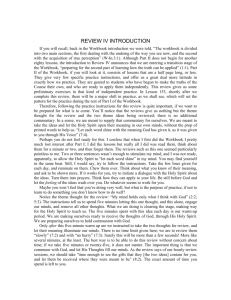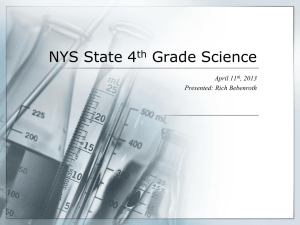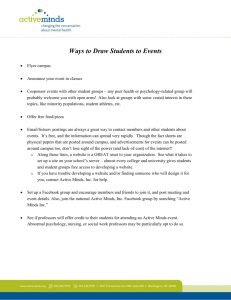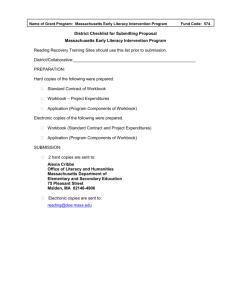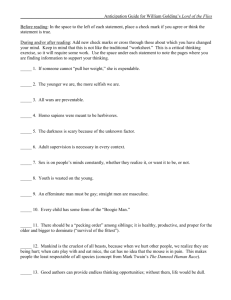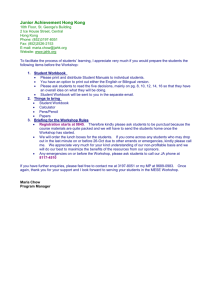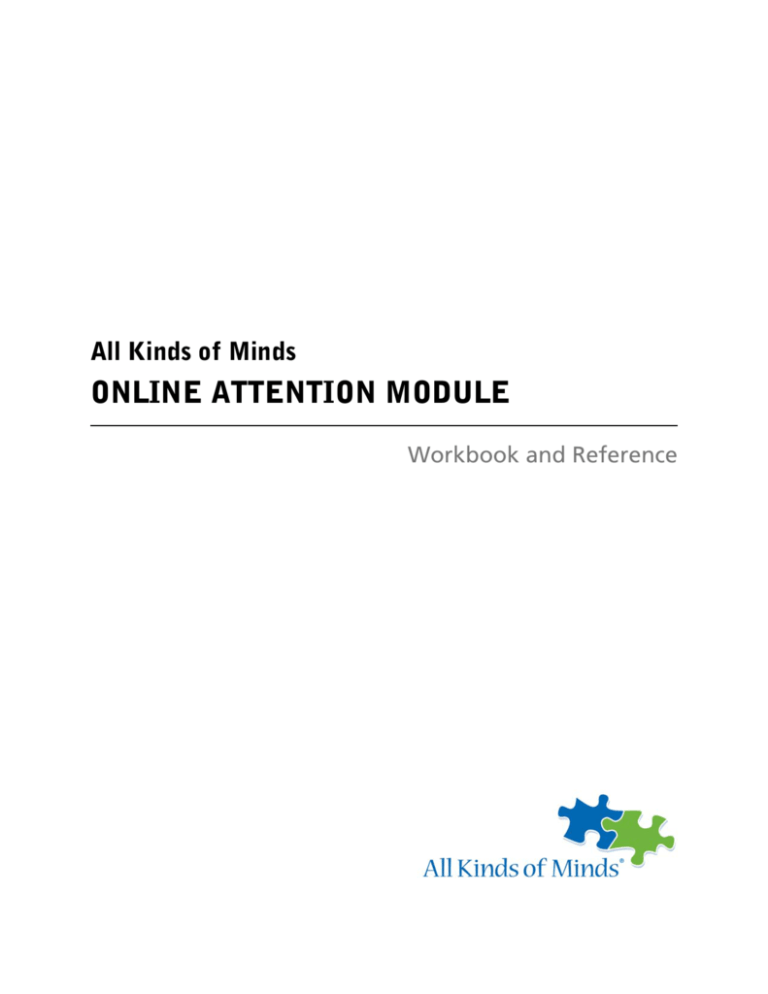
All Kinds of Minds
ONLINE ATTENTION MODULE
Workbook and Reference
Online Attention Module:
TABLE OF CONTENTS:
About this Module......................................................................................................... 1
Tracking your Progress.................................................................................................. 3
Warm-Up Activity .......................................................................................................... 4
Mental Energy Controls ................................................................................................ 5
Signs of Strength, Weakness, Strategies.................................................................................5
Practice Activity and Reflection Questions .............................................................................6
Processing Controls ....................................................................................................... 7
Signs of Strength, Weakness, Strategies.................................................................................7
Practice Activity and Reflection Questions .............................................................................9
Production Controls..................................................................................................... 10
Signs of Strength, Weakness, Strategies...............................................................................10
Practice Activity and Reflection Questions ...........................................................................12
Putting the Pieces Together........................................................................................ 13
Maggie, 13 years old ..............................................................................................................13
Ian, 16 years old......................................................................................................................15
Ben, 8 years old ......................................................................................................................17
Glossary........................................................................................................................ 19
Additional Resources................................................................................................... 20
Copyright 2009 ALL KINDS OF MINDS
All rights reserved.
No part of these materials may be reproduced, stored in a retrieval system, or transmitted in any form or by any means, electronic, mechanical,
photocopying, microfilming, recording, or otherwise, without written permission from All Kinds of Minds.
®
®
All Kinds of Minds and Schools Attuned are registered marks of All Kinds of Minds.
www.allkindsofminds.org
WORKBOOK and REFERENCE
About this Module
Welcome:
Welcome to the online Attention module. This module will help you to describe attention,
including its components and how they are organized, identify a student’s strengths and
weaknesses, and to select appropriate strategies based on those strengths and weaknesses. Below
you will find information to use as a reference for navigating through this online learning
experience.
Before you begin:
•
Print a copy of this Workbook and Reference to have available along with something to write
with.
•
Verify that you have the minimum system requirements:
o A broadband (Cable or DSL) connection is highly recommended.
o Our online courses are designed to work with Internet Explorer V6.1 or higher. If you
have another browser or a lower version of IE, some of the features may not function as
designed. (NOTE: To find out your current version of IE, select the “About Internet
Explorer” link from the “Help” menu.)
o Speakers or headphones and a sound card are required as audio is used throughout the
course.
o Flash animation is used to execute the course. If you do not already have the Flash
player installed, you can download the latest free version at:
http://get.adobe.com/flashplayer/.
•
Review the following module navigation tips:
o
While this module was designed with flexible navigation, we recommend that you
proceed through the module components consecutively. To navigate through the
module components consecutively, use the green > button on the bottom right corner
of the screen. You may also navigate through the module by clicking on headings on
the Menu screen.
o
Practice activities are designed to reinforce key concepts and are not scored. We
recommend that you attempt a practice activity for each aspect of attention.
o
You may exit and return to the module as many times as you like. To exit the module,
close the browser window by clicking on the X in the top right corner of the screen.
Tips for completing the module in several sessions:
1. Use page 3 in this workbook, “Tracking Your Progress,” to track your overall
progress through the module.
2. Use the “Table of Contents” (TOC) feature or the “Menu” feature when you
return to the module to help navigate to where you left off in the previous
session. Both of these buttons are in the bottom right corner of the screen.
ONLINE ATTENTION MODULE
© 2009 All Kinds Of Minds
1
WORKBOOK and REFERENCE
o
Module completion time will vary among users, but generally, we anticipate that it will
take approximately 2-3 hours to review all of the content in this module.
Module Completion:
Once you have visited all of the sections you wish to explore, return to the Menu page and click on
the Submit button in the top right corner of the screen to notify All Kinds of Minds of your module
completion.
Help and Assistance:
If at any time during the course you need assistance, you may reach us via:
•
E-mail : info@allkindsofminds.org.
•
Phone: Call Customer Service at 888.829.5995 during normal business hours (9 a.m. to 5 p.m.
EST, Monday through Thursday).
ONLINE ATTENTION MODULE
© 2009 All Kinds Of Minds
2
WORKBOOK and REFERENCE
Tracking your Progress
Use this page to track your progress through the module.
Introduction – Introduces the three students
Neurodevelopmental Framework – Attention as part of the framework and objectives of the
module
What is Attention? – Defining Attention and its three components
Warm-up Activity – Short matching activity
Aspects of Attention – Use the chart below to track your progress through each of the three aspects
of Attention.
Mental Energy
Controls
(Brain Fuel)
Processing
Controls
(Directing Input)
Production
Controls
(Overseeing
Output)
Explore
Key Ideas
Strategies
Signs of Strength
Signs of Weakness
Develop
Deeper Content
Case Story – 1
Case Story – 2
Secondary Attention Weaknesses
Important Terms
Assessment Tactics – 1
Assessment Tactics – 2
Assessment Tactics – 3
Practice
Practice Exercise
Putting the Pieces Together
Maggie – a 13 year old
Ian – a 16 year old
Ben – an 8 year old
ONLINE ATTENTION MODULE
© 2009 All Kinds Of Minds
3
WORKBOOK and REFERENCE
Warm-Up Activity
Draw a line from each statement to the corresponding aspect of attention on the diagram.
1. Consistent ability to maintain work
effort and follow through on tasks
could indicate a strength in these
controls
2. These controls direct incoming
information
3. These controls oversee academic and
behavior outputs
4. Impulsivity and inconsistency in work
product may be a result of a
weakness in these controls
5. These controls maintain mental
energy for work and learning
6. Difficulty identifying important details
may be a result of a weakness in
these controls
ONLINE ATTENTION MODULE
© 2009 All Kinds Of Minds
4
WORKBOOK and REFERENCE
Mental Energy Controls:
Signs of Strength, Weakness, Strategies
Signs a student’s mental energy controls are operating well:
•
readily starts working and maintains effort level
•
actively engaged when reading or listening
•
appears to have sufficient and reliable energy when working
•
gets adequate sleep in terms of quantity and quality
Signs a student’s mental energy controls are not operating well:
•
has trouble initiating and sticking with tasks
•
does not seem alert when reading or listening
•
appears excessively fatigued when working
•
alertness and energy level fluctuate
•
fidgets and seeks physical stimulation to stay vigilant
•
has trouble falling asleep (despite having a calming bedtime routine), staying asleep, and
waking; may not be fully awake until well into the school day
Some strategies for students whose mental energy controls are not operating well:
•
Routinely change up modalities, such as switching back and forth from a highly verbal
presentation to a nonverbal activity; preview such shifts so that students know how long
they have to maintain their alertness before a transition
•
Allow as much movement as possible while students are working, such as standing at desks
or using fidget objects (like a bean bag that can be manipulated, but that won’t roll or
bounce)
•
Create purposeful breaks such as collecting papers, passing out materials, erasing the
board, or posting lesson objectives
•
Emphasize a staged writing process that segments tasks even more than for most other
students: topic selection, brainstorming, data collection, planning, organizing and
outlining, initial drafting, elaborating, revising, editing, rewriting, and proofing
•
Separate task stages so that relatively little work is done during a given work session
•
Allow some writing assignments to be abbreviated, such as exchanging a bulleted list for a
full text essay
•
Pair students with partners who can help maintain alertness and vigilance through frequent
interaction, task sharing, dialogue, and checking each other’s work
ONLINE ATTENTION MODULE
© 2009 All Kinds Of Minds
5
WORKBOOK and REFERENCE
Mental Energy Controls:
Practice Activity and Reflection Questions
Mr. Bailey is preparing to have a conversation with Janet’s mother about Janet’s weak mental
energy controls. What would be some observations he could share with her during their
conversation? Check all that apply.
Frequently gets asked to play sports with friends
Continually kicks or taps leg of desk
Has paper and pencil ready for morning journal time
Often turns in partially finished math worksheets
Stays engaged throughout the entire afternoon
Keeps desk and classroom materials organized
Regularly lays head on desk when listening to instructions
Sometimes falls asleep during silent reading time
Reflection questions:
When have you experienced difficulty with your mental energy controls? How did that feel?
What did you find most intriguing about mental energy controls?
In your work with students, what tasks place the most demands on their:
- alertness (vigilance for intentional intake of information)
- mental effort (energy allocation for cognitive work)
What additional strategies will you incorporate into your instruction to help your students who
struggle with mental energy controls?
ONLINE ATTENTION MODULE
© 2009 All Kinds Of Minds
6
WORKBOOK and REFERENCE
Processing Controls:
Signs of Strength, Weakness, Strategies
Signs a student’s processing controls are operating well:
•
resists the pull of distractions (such as sights and sounds)
•
maintains focus for adequate stretches of time
•
readily shifts focus during transitions
•
notices key details
•
follows instructions with no need for repetition
•
makes appropriate connections between new information and prior knowledge
•
concentrates during relatively unexciting activities
Signs a student’s processing controls are not operating well:
•
loses focus relatively quickly; susceptible to distractions
•
easily overwhelmed by detailed information
•
has trouble shifting focus during transitions
•
misses key details
•
glosses over material too quickly to absorb it
•
makes tangential connections between new information and prior knowledge
•
has trouble concentrating during relatively unexciting activities
•
seeks a great deal of stimulation, perhaps to the point of risk-taking
Some strategies for students whose processing controls are not operating well:
•
Give verbal advanced warnings about important upcoming information, such as presenting
information in numbered lists (like, “I’m going to tell you about 3 important ideas today.
First, ...”)
•
Provide partially completed graphic organizers or lecture outlines for note-taking; embed
cues in graphic organizers or outlines, such as numbering slots for key details
•
Coach students to use a color-coding system when reading; for example, main ideas could
be underlined in red, details highlighted in blue, and new vocabulary terms highlighted in
yellow; provide a passage that models the color-coding system
•
Employ directed reading activities to promote deeper engagement with the text; for
example, set up a scavenger hunt in which the students need to find certain pieces of
information or a specific number of facts in a reading assignment; end-of-chapter questions
can be used for this purpose
ONLINE ATTENTION MODULE
© 2009 All Kinds Of Minds
7
WORKBOOK and REFERENCE
•
Cloze activities can help students read more closely for detail; for example, conceal parts of
words or whole words in a passage so that the student has to carefully use context clues
•
Highlight specific words in reading materials, such as five to six challenge words (depending
on the length of the text) on which the student should focus; these words might include
unusual letter patterns (like “answer”), multiple syllables, or vocabulary terms from previous
material
•
Have students highlight or circle all math operation signs as an initial step, before starting
to solve any problems
•
Provide practice identifying key details in math word problems by giving problems that have
a large number of extra details that students have to eliminate
•
Encourage students to set up a consistent work space at home, as free from distractions as
possible, where they keep necessary supplies and materials
•
Use a consistent format for organizing information on the board, such as writing
homework assignments in the same order and in the same place each day
ONLINE ATTENTION MODULE
© 2009 All Kinds Of Minds
8
WORKBOOK and REFERENCE
Processing Controls:
Practice Activity and Reflection Questions
Match the term in the left column with the phrase that best describes a related example of
strength.
1. Saliency Determination
a) shares personal associations and
connections during a lecture
2. Processing Depth-Detail
b) studies for tests, regardless of interest in
content
3. Cognitive Activation
c) listens to a story or explanation in its entirety
4. Focal Maintenance
d) determines what information is needed to
solve a problem
5. Satisfaction Level
e) sees the big picture when reading without
losing the details
Reflection questions:
When have you experienced difficulty with your processing controls? How did you manage the
difficulty?
How does what you’re learning about attention in this module match with your prior knowledge of
ADHD?
What instructional techniques do you already use to help students process incoming information?
What additional strategies will you incorporate into your instruction with your students?
ONLINE ATTENTION MODULE
© 2009 All Kinds Of Minds
9
WORKBOOK and REFERENCE
Production Controls:
Signs of Strength, Weakness, Strategies
Signs a student’s production controls are operating well:
•
resists impulses
•
plans before starting tasks
•
works at an appropriate pace
•
notices and corrects mistakes
•
uses feedback from previous experiences to inform decisions
Signs a student’s production controls are not operating well:
•
susceptible to impulses
•
jumps into tasks without sufficient planning
•
rushes through work
•
misses mistakes and opportunities to improve work quality
•
has trouble using feedback from previous experiences to inform decisions
Some strategies for students whose production controls are not operating well:
•
Provide self-monitoring practice through error detection games, such as giving completed
math problems and having students identify and correct errors
•
Collaborate with students to create the scoring/grading guidelines that will be used to
evaluate their work
•
Have students set a letter grade goal or other measure of work quality and have them selfgrade or self-appraise before turning it in; if the self-grade is consistent with the teacher
appraisal, bonus points might be awarded
•
Provide explicit structure for planning (like stating, “Plan for 20 minutes before starting to
work.” or “Every 5-10 minutes you will need to stop and check to see if your plan is still
working.”)
•
Have students share their plans with each other, and provide feedback, before starting to
work
•
Provide practice with thinking ahead and making predictions about social situations, such as
by posing questions like, “What would happen if you told some kids that you didn’t want
to play with them during recess?” or “What if you told your reading partner that he was
doing a good job?”
•
Give students plenty of positive reinforcement whenever they inhibit impulses and make
good choices in social situations; accompany praise with explanation for why a choice was
good
•
Coach and reinforce the use of stepwise plans for solving math problems, including:
picking a strategy, estimating the answer, performing calculations, and comparing the
answer to the estimated answer
ONLINE ATTENTION MODULE
© 2009 All Kinds Of Minds
10
WORKBOOK and REFERENCE
•
Have students color code math problems before attempting any; for example, blue might
mean, “appropriate for mental math” and yellow could indicate, “all steps need to be
written”; check to see that problems have been accurately coded
•
Rather than grading/evaluating just finished written products, provide feedback at several
time points or stages (such as the outline, rough draft, and final draft)
ONLINE ATTENTION MODULE
© 2009 All Kinds Of Minds
11
WORKBOOK and REFERENCE
Production Controls:
Practice Activity and Reflection Questions
In your workbook, circle true (T) or false (F) for each statement.
1. Matt demonstrates a strength in pacing by rushing through things. T or F
2. Barbara has strong academic skills but may have a strength in facilitation and inhibition
because she rarely checks over her work to find and correct mistakes. T or F
3. Rosemary has trouble learning from past experiences and keeps making the same mistakes
over and over again, which indicates she may have a weakness in reinforceability. T or F
4. Emily demonstrates strength in self-monitoring when she thinks through possible options
and chooses the best one. T or F
5. Ian consistently has difficulty predicting outcomes in stories, estimating the answers to math
problems, and anticipating results, which may mean he has a weakness in previewing.
T or F
Reflection questions:
Which would you say works best for you: mental energy controls, processing controls, or
production controls? Why?
What are the best opportunities you have to observe a student’s production controls?
Which of the various aspects of production controls do your students struggle with the most? The
least?
What strategies will you incorporate into your instruction to help those students who struggle with
production controls?
ONLINE ATTENTION MODULE
© 2009 All Kinds Of Minds
12
WORKBOOK and REFERENCE
Putting the Pieces Together
Maggie, 13 years old
Maggie …
• fidgets a lot
• swings from being vigilant to fatigued
• has little stamina for homework
Review the work samples and audio clips to the left of the screen to help you determine which
aspects of Attention are causing Maggie problems and which are functioning okay or even well.
Rate Maggie on a continuum of weakness to strength for each aspect of Attention by placing a
mark on each bar. Click on the hints on the screen for assistance.
Mental Energy Controls
Processing Controls
Production Controls
ONLINE ATTENTION MODULE
© 2009 All Kinds Of Minds
13
WORKBOOK and REFERENCE
Putting the Pieces Together
Maggie, 13 years old (continued)
Choose the strategies you think would be appropriate for Maggie based on her Attention profile.
Check all that apply.
Allow for movement during work time, such as standing at desks or using fidget objects (like a
bean bag that won’t roll or bounce)
Display “speed limit” signs to guide pacing for particular tasks, such as 50 mph for playing and
downtime, 40 mph for reading for fun, 30 mph for reading directions, 20 mph for making a
plan and working, and 10 mph for checking work; remind the whole class what the speed limit
is for the task at hand
Create purposeful breaks such as collecting papers, passing out materials, erasing the board, or
posting lesson objectives
Provide self-monitoring practice through error detection games, such as giving completed math
problems and having students identify and correct errors
Separate task stages so that relatively little work is done during a given work session
Pair students with partners who can help maintain alertness and vigilance through frequent
interaction, task sharing, dialogue, and checking each other’s work
Coach and reinforce the use of stepwise plans for solving math problems, including: picking a
strategy, estimating the answer, performing calculations, and comparing the answer to the
estimated answer
Give advanced warnings about important upcoming information, such as presenting
information in numbered lists (like, “I’m going to tell you about 3 important ideas today.
First, …”)
Provide practice with thinking ahead and making predictions about social situations, such as by
posing questions like, “What would happen if …?”
Emphasize a staged writing process that segments tasks: topic selection, brainstorming, data
collection, planning, organizing and outlining, initial drafting, elaborating, revising, editing,
rewriting, and proofing
Additional strategies (optional):
ONLINE ATTENTION MODULE
© 2009 All Kinds Of Minds
14
WORKBOOK and REFERENCE
Putting the Pieces Together
Ian, 16 years old
Ian …
• is highly distracted by sights and sounds
• is also distracted by his own thoughts
Review the work samples and audio clips to the left of the screen to help you determine which
aspects of Attention are causing Ian problems and which are functioning okay or even well.
Rate Ian on a continuum of weakness to strength for each aspect of Attention by placing a mark
on each bar. Click on the hints on the screen for assistance.
Mental Energy Controls
Processing Controls
Production Controls
ONLINE ATTENTION MODULE
© 2009 All Kinds Of Minds
15
WORKBOOK and REFERENCE
Putting the Pieces Together
Ian, 16 years old (continued)
Choose the strategies you think would be appropriate for Ian based on his Attention profile. Check
all that apply.
Allow for movement during work time, such as standing at desks or using fidget objects (like a
bean bag that won’t roll or bounce)
Provide partially completed graphic organizers or lecture outlines for note-taking; embed cues in
graphic organizers or outlines, such as numbering slots for key details
Create purposeful breaks such as collecting papers, passing out materials, erasing the board, or
posting lesson objectives
Provide self-monitoring practice through error detection games, such as giving completed math
problems and having students identify and correct errors
Coach and reinforce the use of stepwise plans for solving math problems, including: picking a
strategy, estimating the answer, performing calculations, and comparing the answer to the
estimated answer
Give advanced warnings about important upcoming information, such as presenting
information in numbered lists (like, “I’m going to tell you about 3 important ideas today.
First, …”)
Employ directed reading activities to promote deeper engagement with the text in which
students need to find certain pieces of information
Provide practice identifying key details in math word problems by giving problems that have a
large number of extra details that students have to eliminate
Have the student keep track of “mind trips” on a score sheet of some kind and provide rewards
for increasing amount of time on-task
Provide practice with thinking ahead and making predictions about social situations, such as by
posing questions like, “What would happen if …?”
Additional strategies (optional):
ONLINE ATTENTION MODULE
© 2009 All Kinds Of Minds
16
WORKBOOK and REFERENCE
Putting the Pieces Together
Ben, 8 years old
Ben …
• rushes through work
• rarely checks his work
• is quite impulsive
Review the work samples and audio clips to the left of the screen to help you determine which
aspects of Attention are causing Ben problems and which are functioning okay or even well.
Rate Ben on a continuum of weakness to strength for each aspect of Attention by placing a mark
on each bar. Click on the hints on the screen for assistance.
Mental Energy Controls
Processing Controls
Production Controls
ONLINE ATTENTION MODULE
© 2009 All Kinds Of Minds
17
WORKBOOK and REFERENCE
Putting the Pieces Together
Ben, 8 years old (continued)
Choose the strategies you think would be appropriate for Ben based on his Attention profile.
Check all that apply.
Allow for movement during work time, such as standing at desks or using fidget objects (like a
bean bag that won’t roll or bounce)
Display “speed limit” signs to guide pacing for particular tasks, such as 50 mph for playing and
downtime, 40 mph for reading for fun, 30 mph for reading directions, 20 mph for making a
plan and working, and 10 mph for checking work; remind the whole class what the speed limit
is for the task at hand
Provide self-monitoring practice through error detection games, such as giving completed math
problems and having students identify and correct errors
Separate task stages so that relatively little work is done during a given work session
Pair students with partners who can help maintain alertness and vigilance through frequent
interaction, task sharing, dialogue, and checking each other’s work
Coach and reinforce the use of stepwise plans for solving math problems, including: picking a
strategy, estimating the answer, performing calculations, and comparing the answer to the
estimated answer
Have the student keep track of “mind trips” on a score sheet of some kind and provide
rewards for increasing amount of time on-task
Provide practice with thinking ahead and making predictions about social situations, such as by
posing questions like, “What would happen if …?”
Emphasize a staged writing process that segments tasks: topic selection, brainstorming, data
collection, planning, organizing and outlining, initial drafting, elaborating, revising, editing,
rewriting, and proofing
Give plenty of positive reinforcement whenever the student inhibits impulses and make good
choices in social situations; explain why choice were good
Additional strategies (optional):
ONLINE ATTENTION MODULE
© 2009 All Kinds Of Minds
18
WORKBOOK and REFERENCE
Glossary
Attention Network of controls over brain performance, including mental
energy, processing of incoming information, & regulation of output
Alertness Vigilance for intentional intake of information
Cognitive Activation Using incoming information to trigger new ideas & connect with
prior knowledge & experience
Energy Flow Reliability of cognitive energy supply
Facilitation-Inhibition Appropriate response inhibition; consideration of options for action,
suppression of ill-advised output prior to acting or starting a task
Focal Maintenance Appropriately sustaining, transitioning, & dividing focus on incoming
information (sometimes called attention span or sustained attention)
Mental Energy Controls Functions regulating the initiation & maintenance of cognitive
energy flow for learning, work, & behavioral control
Mental Exertion Energy allocation for cognitive work
Pacing Working or acting at a rate that is appropriate to the task, without
rushing
Previewing Anticipation of likely outcomes (e.g., of plans, actions, events, &
statements)
Processing Controls Functions regulating the processing of incoming information
Processing Depth-Detail Intensity of focus for interpreting & storing incoming
stimuli/information
Production Controls Functions regulating the quality of academic output & behavioral
control
Reinforceability Use of previous experience & prior knowledge to guide current
action
Saliency Determination Discrimination between more & less important inputs (sometimes
called selective attention)
Satisfaction Level Capacity to focus on activities or topics yielding only moderate or
low levels of excitation; relative need for intense stimulation &
gratification
Secondary Attention Behaviors or challenges that may appear to be due to weak
Weakness attention, but is actually caused by something else, like weak
language or memory
Self-Monitoring Observing one’s own output & work (in process or after the fact) in
order to detect mistakes or deviations from goals so as to make
necessary modifications
Sleep-Arousal Balance Regulation of sleep/wake cycles
ONLINE ATTENTION MODULE
© 2009 All Kinds Of Minds
19
WORKBOOK and REFERENCE
Additional Resources
To learn more about attention and the neurodevelopmental framework:
•
Use the Neurodevelopmental Framework on the All Kinds of Minds website
www.allkindsofminds.org/researchreviews.aspx
•
Use the “Glossary” on the All Kinds of Minds website
www.allkindsofminds.org/glossary.aspx
•
View the Developing Minds video series
www.shop.wgbh.org/category/show/1062
•
Read A Mind at a Time by Dr. Mel Levine
To learn more about assessing learning problems:
•
Read Revealing Minds by Dr. Craig Pohlman
•
Read How Can My Kid Succeed in School? by Dr. Craig Pohlman
To find more strategies to help struggling learners:
•
Use the “LearningBase on the All Kinds of Minds website
www.allkindsofminds.org/learningBase.aspx
•
Read Educational Care by Dr. Mel Levine
ONLINE ATTENTION MODULE
© 2009 All Kinds Of Minds
20

